Marine
Assessing Plankton in the UK
February 3, 2020 by Marine Directorate Communications No Comments | Category Collaborations, European Maritime and Fisheries Fund (EMFF), Marine Directorate general, Marine Directorate Science, Marine Directorate Surveys, Scottish Coastal Observatory
Two scientists from Marine Scotland Science (MSS), Dr Eileen Bresnan and Dr Margarita Machairopoulou, have been involved in the first ever assessment of the status of the plankton community in UK waters.
Led by the University of Plymouth, scientists from all around the UK joined together to share their datasets and knowledge to fill in some of the scientific gaps and understand change in pelagic habitats. The collective expertise of the group was critical in producing and interpreting the results.
Key to this assessment is the development of a new plankton lifeform indicator tool which enables assessment of pelagic habitat plankton diversity, regardless of sampling methods. There are thousands of phytoplankton and zooplankton species in UK waters – for this analysis they are collated into functional groups, called lifeforms, that perform similar functions in the ecosystem or have similar biochemical characteristics and lifecycles. Examples of lifeforms are: diatoms/dinoflagellates (silicate/flagellated microalgae) and holoplankton/meroplankton (animals that spend whole/part of their lifecycle in the water column).
This map shows the location of the different plankton monitoring programmes that were included in the assessment. Data from the MSS Scottish Coastal Observatory (SCObs) stations has made a key contribution to this study, particularly in the data poor areas on the west coast of Scotland. The SCObs monitoring sites at Stonehaven and Loch Ewe represent two of the three monitoring sites in the UK (L4 off Plymouth) where coastal zooplankton are monitored.
 The main findings from the ICEGRAPH Project include:
The main findings from the ICEGRAPH Project include:
- That the plankton community in UK waters has exhibited profound changes in distribution and abundance. For example, meroplankton (plankton who spend only part of their life cycle in the water column e.g. the larvae of star fish, sea urchins) are showing an increasing trend in abundance in both coastal and offshore areas around the UK. While diatoms (a type of microscopic algae) are increasing only in the northern North Sea (including areas around Orkney and Shetland), as well as the south east of England. However, some life forms e.g. dinoflagellates (another type of microscopic algae) show different trends between coastal (increasing) and offshore (decreasing) areas.

- These changes in the plankton community can impact energy flow in the marine food web to higher trophic levels (e.g. shifts in the balance between the abundances of small and large copepods (small crustaceans) can potentially alter the quality of food available to fish). The impacts of these changes on commercial fish stocks require investigation.
- Some of these changes have been linked to sea surface temperature (SST), which has warmed around the UK. SST has been used as a proxy for climate change as other physical/biological factors such as water column stability/ prey availability which can influence plankton abundances are also influenced by warming temperatures.
Further Information:
- The ICEGRAPH Project is funded by the European Maritime and Fisheries Fund (EMFF) and the Marine Management Organisation (MMO).
- Plankton are organisms that live and drift in the water column. Phytoplankton are microscopic single celled algae. They occupy the base of the marine food web using the energy from sunlight to produce carbohydrates and releasing oxygen via the process called photosynthesis. Phytoplankton are ecologically important. They are a major food source for zooplankton, act as a carbon sink by taking up CO2 dissolved in the water and producing 50% of the earth’s oxygen. Zooplankton are animals with sizes that range from microscopic (e.g. star fish larvae) to visible with the naked eye (e.g. jellyfish). They feed on phytoplankton and some on other zooplankton. Zooplankton, in turn, are preyed on by fish larvae some of which have a high commercial importance such as cod and herring. Thus energy from phytoplankton is passed up the food web.
- The water above the seabed is called the pelagic habitat. It is really important to be able to assess the status of the plankton in the pelagic habitat as it allows the detection of change that could potentially impact higher trophic levels and negatively impact the marine ecosystem.
- Scottish Coastal Observatory (SCObs) topic sheet
- SCObs report
- North Atlantic Fisheries College
- Orkney Harbour Authority
- Improving Confidence Evaluating GES for Regional Assessments of Pelagic Habitats (ICEGRAPH)
Tags: climate change, coastal monitoring, European Maritime and Fisheries Fund, ICEGRAPH, Loch Ewe, marine food web, Marine Management Organisation, Monitoring, pelagic, phytoplankton, plankton, research, sampling, science, SCObs, Scotland, Scottish Coastal Observatory, Stonehaven, Survey, zooplankton





Leave a comment